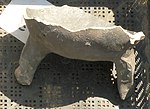Weidemannscher Hof
The Weidemannsche Hof was an agricultural farm in Pattensen in the Hanover region in Lower Saxony that was demolished in 2018. The property is named after the Weidemann family, who owned it since the beginning of the 19th century. During the High Middle Ages , one of eight Burgmannshöfen was located on the property , which belonged to the first development of the village, which was built around 1200. It later became a manor .
history
The plot of land on which the Weidemannsche Hof was located, which has been used as a settlement area for over 800 years, is located in the historic center of Pattensen, in the immediate vicinity of the former Pattensen Castle. The castle was probably built on a slight hill by the Counts of Hallermund at the end of the 12th to the beginning of the 13th century. This area of the city was inhabited at least from the end of the 12th century. Probably when the castle was founded, there was a Burgmannshof on the plot of what would later become the Weidemannschen Hof, which was used to supply the castle residents with food from agriculture, household goods and crews ( Burgmannen ). An official description from the 18th century names eight Burgmannshöfe in Pattensen.
Later there was a manor on the property, which was called manor V because of four other manors in the village . Around 1800 it was owned by the von Reden family . They sold it to Georg Heinrich Louis Weidemann in 1836. In 1844 the property lost its function as a manor. In 1852 the owner Georg Weidemann had part of the old building renovated. His son Georg built further buildings in 1885, so that a three-sided courtyard was created during this time .
In the mid-1980s, the last member of the Weidemann family left the farm. In 2013, the city of Pattensen acquired the approximately 2200 m² courtyard property, which local politicians described as a “fillet” in the old town. Initially, the city planned to build a new town hall there, but refrained from doing so because of the confined space. In 2017 the property was sold to a company for the construction of residential buildings. As there was no monument protection , the Dreiseithof was completely demolished in 2017. The new building is to retain the previous design.
excavation
After the demolition, there were five months of urban archaeological investigations on the cleared property of the Weidemannsche Hof in 2018 , which an excavation company carried out on behalf of the Hanover region. They enabled a closer study of the local history. Due to the destruction of Pattensen in the Hildesheim collegiate feud and three large city fires, last in 1733, there is only a fragmentary tradition.
The finds and findings found during the excavations go back to the High Middle Ages . The archaeologists uncovered an approximately 20 m² stone cellar, which they dated to the end of the 12th to the beginning of the 13th century using a beaker tile as an early stove tile. At that time, tiled stoves were only widespread in northern Germany as a smoke-free heat source in church and aristocratic environments. Another find that points to the aristocratic context of the plot and, according to Ute Bartelt, local archeologist for the Hanover region, to the existence of a Burgmannshof, was an iron riding spur . Ball pots and Pingsdorf ceramics were also found objects .
Furthermore, pit houses from the 12th to 14th centuries were uncovered on the site . A total of 15 wells were found, most of which had a well tube made from a hollowed-out tree trunk. Four wells from the 17th and 18th centuries with a stone well tube and a barrel loa ( latrine ) came from the early modern use of the area . There were also more cellars and a wooden box well. A total of around 1,000 finds were recovered. You come to the Lower Saxony State Museum in Hanover .
- Findings
literature
- Wolfgang Ewig: From Burgmannshöfen to noble residences - The manors of the von Redens in Pattensen , 2015
Web links
- Pattensen: Traces from the Middle Ages found at ndr.de on July 24, 2018
-
Information and photos on the demolition of the Weidemannschen Hof at the executing company
- Start of earthworks on March 6, 2018
- Preparations for the demolition on August 4, 2017
- Demolition work on August 25, 2017
- After the demolition work on September 20, 2017
Individual evidence
- ↑ Archaeological excavation in the old town of Pattens at hannover.de on July 24, 2018
- ↑ Stephanie Zerm: Only the "Klaterburg" is still in Neue Presse from March 11, 2015
- ↑ Kim Gallop: Talstraße: Hofgeschichte is in ruins in HAZ from September 9, 2017
- ↑ Photo of the memorial stone for the erection in HAZ
- ↑ Kim Gallop: Family makes a farewell visit to the old farm in HAZ on August 23, 2015
- ↑ Kim Gallop: Historischer Hof will soon be history in HAZ from August 18, 2017
- ↑ Tobias Lehmann: Construction committee against location for collective accommodation in HAZ from June 13, 2016
- ↑ Tobias Lehmann: Mertesacker / Fritz buy Ratskeller in HAZ from March 27, 2017
- ↑ City of Pattensen sells property on Talstrasse and the Ratskeller in LeineBlitz on March 23, 2017
- ↑ Demolition work in Pattenser Talstrasse is progressing at CP Immobilien from August 25, 2017
- ↑ Kim Gallop: Burgmannshof: excavation confirms location in Hannoversche Allgemeine Zeitung (HAZ) of July 27, 2018
- ↑ Talstraße: Archaeologists present finds in HAZ on July 27, 2018
Coordinates: 52 ° 15 ′ 50.1 ″ N , 9 ° 45 ′ 45.2 ″ E










